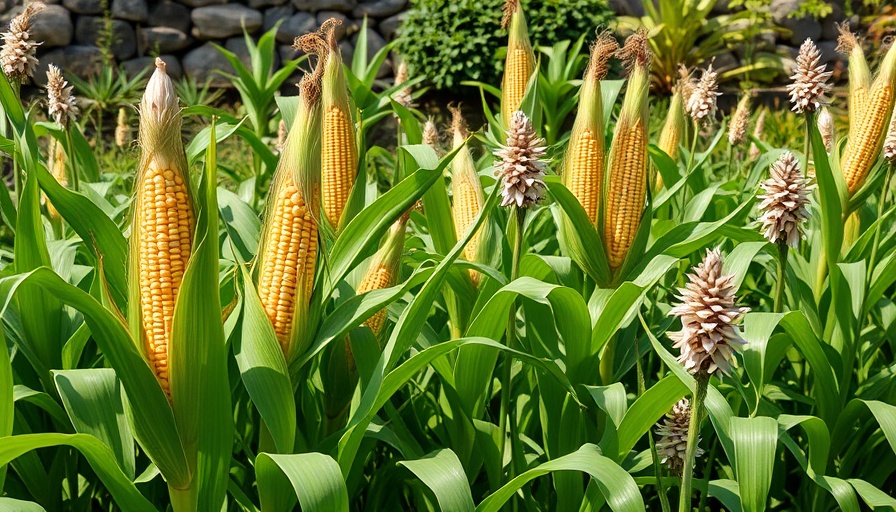
Unlocking the Secrets of Companion Planting with Corn
Companion planting is one of nature's most ingenious gardening strategies, promoting biodiversity and helping us cultivate healthier crops. Among the numerous plants that flourish in close quarters, corn stands out due to its height, growth patterns, and its vital role in the traditional practice of the "Three Sisters"—a method embraced by Native American agriculturalists. Not only does corn serve as a luxurious support system for climbing plants, but it also significantly improves the nitrogen content of the soil when planted alongside compatible species.
Discover the Best Companion Plants for Your Corn
Here are nine excellent companions to enhance your corn-growing experience:
- Basil - Famous for its culinary uses, basil is also a key player in pest management. Its aroma wards off maize weevils, providing a protective barrier for your corn. Simply plant basil around your corn patch, or scatter crushed basil leaves at the base of each stalk for extra pest deterrence.
- Dill - Dill attracts beneficial insects and pollinators while keeping pests at bay. Its feathery foliage complements the tall cornstalks nicely.
- Nasturtiums - These vibrant flowers not only beautify your garden but also deter aphids and other pests that threaten your crops.
- Pole Beans - An ideal companion for corn, pole beans will climb up the stalks, fixing nitrogen in the soil and enhancing the overall nutrient levels.
- Potatoes - Both corn and potatoes thrive on similar watering schedules, making them great partners. Just avoid planting them too closely to prevent competition for nutrients.
- Pumpkins - Corn offers ideal shade and support for growing pumpkins, which can sprawl beneath the cornstalks without overcrowding.
- Radishes - These quick-growing plants suppress weeds and can be harvested before the corn reaches maturity.
- Sunflowers - A stunning companion, sunflowers not only attract bees but also provide shade that can benefit growing corn.
- White Clover - This low-growing plant works as a natural ground cover, adding nitrogen to the soil and preventing weeds.
The Historical Context of Companion Planting
Historically, the practice of companion planting has roots in various cultures around the world. The "Three Sisters" method highlights how Native Americans used corn, beans, and squash harmoniously in their agriculture. Each plant plays a distinct role; beans enrich the soil with nitrogen, while squash sprawls over the ground, protecting moisture and suppressing weeds. The wisdom embedded in this practice underscores the importance of diversity in gardening.
How Companion Planting Improves Soil Health
When certain plants grow together, they can support each other in remarkable ways. For instance, the nitrogen-fixing capabilities of beans not only nourish the soil for corn but also ensure that the corn remains robust and resilient against pests. As sustainable gardening approaches gain popularity, understanding these symbiotic relationships fosters healthier garden ecosystems.
Benefits of Incorporating Companion Plants
Planting companions can yield various benefits for your garden, such as:
- Natural Pest Control: Many companion plants deter harmful pests through their natural properties or by attracting beneficial insects.
- Optimized Space: Utilizing vertical space, corn acts as a trellis for climbing beans and cucumbers, maximizing garden efficiency.
- Biodiversity: Enhancing plant diversity can reduce the likelihood of diseases and promote a balanced ecosystem.
Practical Tips for Successful Companion Planting
To get the most out of your companion planting efforts, consider these simple tips:
- Research compatible plants to ensure they thrive together.
- Monitor growth and interactions regularly; adjust placements if needed.
- Rotate plants each season to enhance soil health and keep pests at bay.
A Call to Action for Garden Enthusiasts
Now that you've explored some of the best companion plants for corn, it's time to put this knowledge into action! Whether you’re a seasoned gardener or just starting your journey, integrating companion planting into your gardening strategy will enhance your yields and foster a healthier garden ecosystem. So grab your seeds, plot out your garden beds, and enjoy the symbiotic relationships that nature has to offer!
 Add Row
Add Row  Add
Add 




Write A Comment